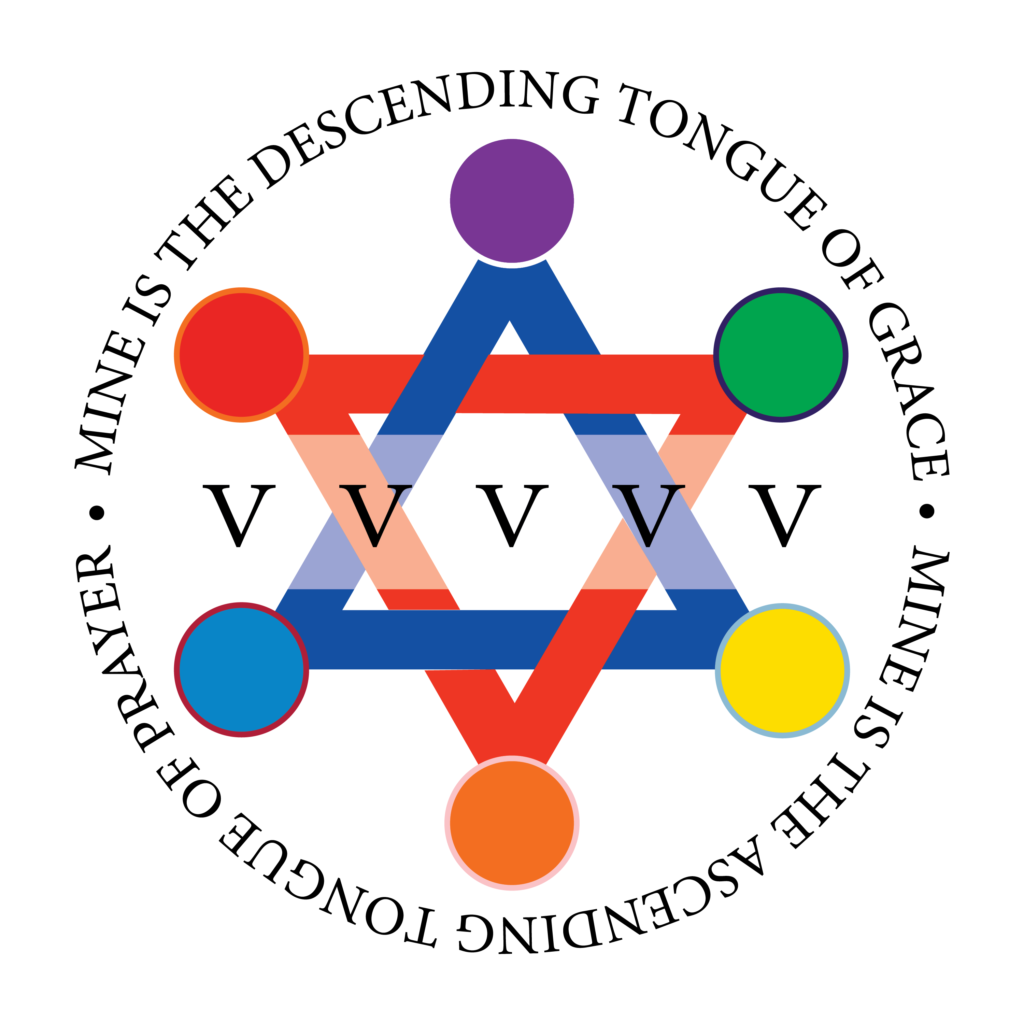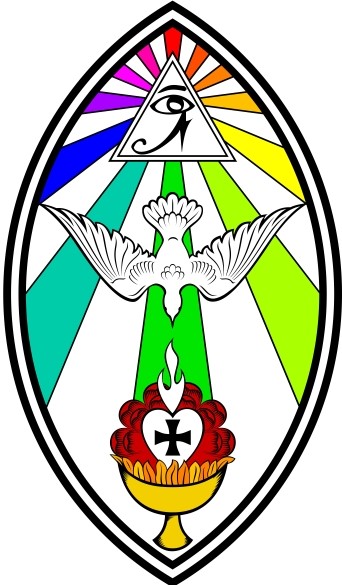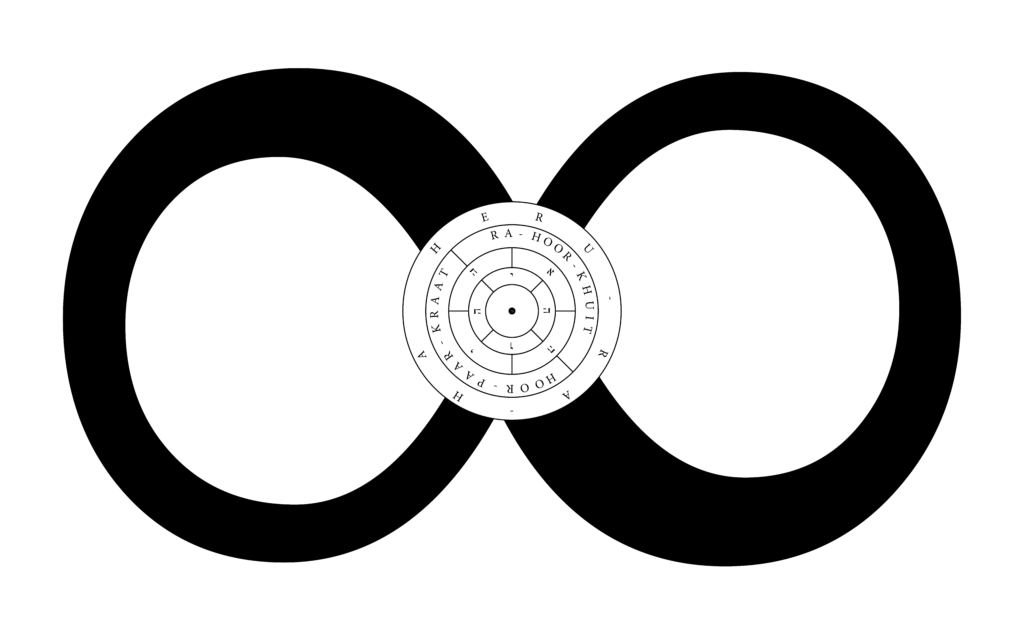
The way up and the way down is one and the same.
— Heraclitus, Fragment 60
One way to understand Thelema is as an account of the interplay between the upward path and the downward path.
The path up is variously described as waking up, the union of the individual with God, Knowledge and Conversation of the Holy Guardian Angel, and Crossing the Abyss. This process is described in The Wake World and in One Star In Sight.
The path down is the path whereby a god incarnates in order to live a life in this world. This process is described in detail in Crowley’s commentaries on the Book of the Law. This process is also the main theme of the Man of Earth degrees of O.T.O.
In its most general sense, the path up is the movement from the Many back to the One and ultimately the None, while the path down is the movement from the None out into the Many.
While it appears briefly at the end of The Wake World with the birth of the new Fairy Prince, and while it is implied by the 0=2 theorem, the path down only seems to have become a major theme of Crowley’s spirituality after his experience of crossing the Abyss. This shift in emphasis coincides with and is reflected not only in The Book of Lies and in The Gnostic Mass, but also in Crowley’s decision to make Thelema the overarching framework of his whole spiritual approach.
You can think of the upward path as a process of dying. There is a movement from speech to silence, from motion to stillness, from the real to the ideal, from time to eternity. As one writer has expressed it, the death that others call “life” is rejected in favor of the life that others call “death”. Thus the ordeal of the second order of A∴A∴ is death.
On the other hand, the path downward is a process of birth, which is the ordeal of the third order of A∴A∴. There is a movement from silence to speech, from stillness to motion; there is the transformation of the real in light of the ideal, and there is a view of time as a moving image of eternity. The Magister Templi teaches. The Magus fecundates the world with a Word. We witness the movement from One back to Many.
The implication seems clear. Awakening is neither an escape from this world nor merely an individual process. The world—this world, right here—is regenerated through the awakening of individuals which Crowley calls “Saints”. Their spiritual community—the Communion of Saints—is the invisible church behind all outward manifestation or appearance which is responsible for the regeneration of appearances.
Both trajectories are represented in the Gnostic Mass. Section IV is the upward path, and Section VIII is the downward path. It is often supposed that the climax of Section VIII (and of the ritual itself), the point at which the Priest and Priestess depress the lance point and the particle into the cup, somehow represents the destruction or annihilation of the Priest or of his ego in Babalon or in the All. But this represents a misunderstanding both of the narrative structure of the ritual itself as well as of what is involved in spiritual awakening from a Thelemic perspective.
First, if there is any “annihilation” of the personality of the Priest represented in the Gnostic Mass, it occurred at the parting of the veil, when the Priest (the microcosm) united himself with the Priestess (the macrocosm). Many details of the ritual support this interpretation. The Priestess speaks in the voice of Nuit or Heaven, and the Priest adores her as such. He isolates the secret flame or essence within himself and offers it up to her, who he addresses as “One,” the “Sun,” “Pan,” and “IAO” among other names. He then kneels before her and adores her while the Collects are read by the Deacon. These Collects number 11 in total, a number signifying the union of the microcosm (5) with the macrocosm (6). All signs point toward the parting of the veil being the culmination of the upward path and the raising up of the individual to the divine.
Now if we were Theravada Buddhists or Gnostic Christians, we would call it a day. The Children would blow out the candles, close the veil, and send everyone on their merry way. But the Thelemic version of awakening does not terminate in the alleged destruction of the personality in the One or in Nibbana. The point of Thelemic awakening is not to achieve something for the individual, not even his or her own destruction, but rather to complete the cosmological process which gave rise to that individual by in turn re-seeding and regenerating the Earth.
Thus we witness a clear trajectory of the Priest. He begins in the darkness of the tomb. The Virgin/Priestess opens this tomb, purifies and consecrates him, and leads him to unfold himself into her light. In this light, he produces a “fruit of labor”. In Section VIII of the ritual, the Priest breaks open this fruit, and from it, he produces his seed. He then vibrates “AUMGN” three times. AUMGN of course is a formula representing the entire cosmological process from silence into manifestation and back into silence again. It is precisely this process which is ritualized throughout the course of the Gnostic Mass, and as such, AUMGN is the word vibrated most often throughout the ritual.
Much has been made of the “seed” of the Priest being his sperm, and people debate to what extent the Gnostic Mass is a sublimated sex magic operation. This is the wrong question to ask. The question is not whether one type of magical act is an instance of another but rather, what is the genus of which both are species? Whether the eucharistic talisman in question is a spermatazoon or a particle of bread, what is it a talisman or vehicle of?
It’s already been made clear that the particle of bread is a vehicle of Harpocrates, the God of Silence. We know from earlier in the Mass that the wine in the cup is the “Vehicle of the joy of Man upon earth”. We might therefore consider the placement of the bread particle in the cup of wine as the seeding of the Earth with something silent, secret, and divine. This seed shall germinate in the black soil and push its shoot through the darkness, out into the light. What will the seed of the God of Silence grow into?
Of course it expands into the Babe in the Egg and ultimately into Baphomet, the Lion-Serpent. You know this if you’ve attended the ritual. And if you’ve read my previous posts, you know I consider Baphomet to be a type of the Holy Guardian Angel. But what is the significance of that outcome? What is its spiritual meaning?
According to Aristotle, the being of anything is given by its outward, perfected form, i.e., by its characteristic appearance when it is fully-grown. The destiny of the seed planted in the Earth in the Gnostic Mass is to become “the Devil,” Ayin, the letter “O”.
[The Devil] is also the vowel O, proper to roar, to boom, and to command, being a forcible breath controlled by the firm circle of the mouth. He is the Open Eye of the exalted Sun, before whom all shadows flee away: also that Secret Eye which makes an image of its God, the Light, and gives it power to utter oracles, enlightening the mind. Thus, he is Man made God, exalted, eager; he has come consciously to his full stature, and so is ready to set out on his journey to redeem the world. —Magick in Theory and Practice, Chapter V
Paradoxically, the path naturally taken by the seed of the god of silence leads it to become a kind of speech. It is the speech which drives away the shadows, which utters in an oracular fashion, which enlightens the minds of those that hear it, and which redeems the world.
Thus having adored the Lion-Serpent:
The PRIEST joins hands upon the breast of the PRIESTESS, and takes back his Lance. He turns to the People, lowers and raises the Lance, and makes ☩ upon them.
Do what thou wilt shall be the whole of the Law.
Which god is the Book of the Law the speech of? Who in particular does Thelema come from? We’re given a name, and it’s not “Aleister Crowley” or even “Aiwass”. There is one particular deity governing this spiritual revelation, and the Gnostic Mass is the ritualistic implanation of his seed in the black soil of the Earth. But to what end?
If this be not aright; if ye confound the space-marks, saying: They are one; or saying, They are many; if the ritual be not ever unto me: then expect the direful judgments of Ra Hoor Khuit! This shall regenerate the world, the little world my sister, my heart & my tongue, unto whom I send this kiss.
—Liber AL vel Legis, I.52-53
I fly and I alight as an hawk: of mother-of-emerald are my mighty-sweeping wings. I swoop down upon the black earth; and it gladdens into green at my coming. Children of Earth! rejoice! rejoice exceedingly; for your salvation is at hand.
—Liber Tzaddi, 0-3
Now and again Travellers cross the desert; they come from the Great Sea, and to the Great Sea they go. As they go they spill water; one day they will irrigate the desert, till it flower.
—The Book of Lies, Chapter 42, “Dust Devils”

The fruit of the silent seed ritualistically implanted every time we celebrate the Gnostic Mass is a word, and that word is Thelema. The destiny of this word is to regenerate the world to such a radical degree that not only is the Minutum Mundum fertilized, but the entire Tree of Life itself transformed, so that even the Abyss itself turns green—but only if we truly listen to that word.
My child, he who listens must perceive the same as he who speaks, share his awareness; he must breathe together with him, share the same spirit; his hearing must be sharper than the voice of him who speaks.
—Corpus Hermeticum, X.17
If we listened even more intensely than we spoke, we would hear not only the word but also the silence concealed within the word. When we don’t attend, when we don’t open ourselves, when we don’t make ourselves vulnerable to the silence in the speech, the word goes in one ear and out the other. We end up considering the Gnostic Mass to be a performance put on by a club. We think of Thelema as just one current among other magical currents, maybe in need of a little “supplementation” here and a little “balancing” over there. We think we know better than Aleister Crowley—and we do!—but do we know better than the gods? Or more to the point: are we so sure we have sufficiently attuned ourselves to the silence each of us carries within ourselves? Probably not. We’re too busy proving how much smarter we are than Crowley to have bothered truly listening. Because if we truly listened—and most people are lucky if they listen even once in their lives for something they don’t already know—then we would realize that the divine at the center and origin of Thelema is not peculiar to Thelema but instead is the source and seed of all true religion. It is the germ of the process which has renewed the cosmos since its beginning. It is the source of wisdom and of meaning which we are desperately starved for in our technologically advanced culture.
And what is Thelema’s role in all of this? To bring these seeds to the Earth in a shower. To deluge the Earth with light, life, love and liberty.
Thelema represents radical fecundity.
When we set out upon any spiritual path, we are usually looking for strategies to fulfill some absence in our lives. We are looking to get something for ourselves. Thelema has a great deal to offer individuals. Indeed, individuals are the focus of Thelema. Unfortunately, so many people come to Thelema (and spirituality generally) looking for confirmation for what they already believe. They want something which will pander to their egos. And so they say “my will is this” and “my angel told me that”.
But if we listened and attuned ourselves to what is true in Thelema—not true in the sense of just being another true fact about the world, but true in the sense of being eternal and transpersonal—then we would open ourselves to something epic in scope and cosmological in significance. From the point of view of cultic practice, the Gnostic Mass is the occasion to do this. It represents the regeneration of the world by means of Thelema in a way people can see, hear, smell, touch, taste, eat, and drink—such that each of us, crossing our arms in an attitude of resurrection, may say with real understanding this time:
There is no part of me that is not of the Gods!




